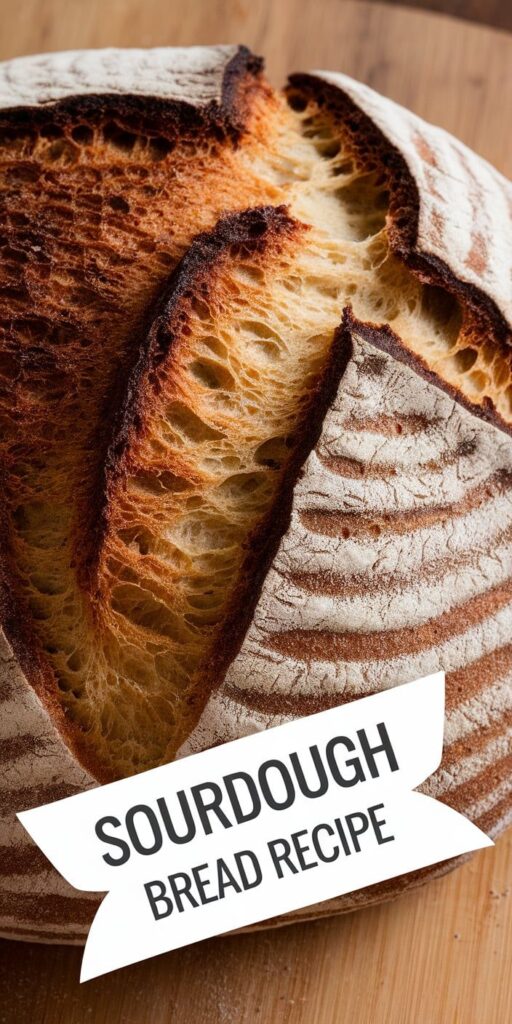Welcome to the ultimate journey of creating delicious homemade sourdough bread! As an avid home baker, I’m excited to share my passion for crafting the perfect artisan bread recipe that transforms simple ingredients into a culinary masterpiece.
Sourdough bread isn’t just a recipe—it’s an art form that connects us to traditional baking techniques. My comprehensive guide will walk you through every step of creating a stunning loaf, from nurturing your starter to pulling a golden-brown bread from the oven.
Whether you’re a beginner or an experienced baker, this homemade sourdough bread recipe will demystify the process and help you create restaurant-quality bread right in your own kitchen. We’ll explore the magic of fermentation, learn essential techniques, and discover why sourdough is more than just bread—it’s a delicious adventure.
Get ready to embark on a baking journey that will transform your understanding of bread making. Let’s dive into the world of sourdough!

Why I Love Making Traditional Sourdough Bread at Home
My passion for traditional sourdough bread started unexpectedly. What began as a curious kitchen experiment transformed into a delightful culinary journey that changed my relationship with bread forever. The rich, complex flavors and incredible health benefits of homemade sourdough quickly captured my heart.
My Personal Sourdough Baking Adventure
When I first started baking sourdough, I was intimidated by the process. Creating a living starter seemed like magic. I learned that patience and consistency were key to mastering this ancient bread-making technique. Each loaf became a learning experience, teaching me about fermentation, texture, and flavor development.
Incredible Health Benefits of Sourdough
The sourdough health benefits are remarkable. Unlike commercial bread, traditional sourdough undergoes a slow fermentation process that breaks down gluten and increases nutrient availability. This makes it easier to digest and potentially more nutritious.
- Improved digestibility
- Lower glycemic index
- Enhanced nutrient absorption
- Potential probiotic properties
What Sets Sourdough Apart
Traditional sourdough bread differs significantly from regular bread. The natural fermentation process creates a unique flavor profile and texture that commercial yeast simply cannot replicate. Each loaf tells a story of wild yeasts and bacteria working together to create something truly special.
| Characteristic | Sourdough Bread | Commercial Bread |
|---|---|---|
| Fermentation Time | 24-48 hours | Minutes |
| Flavor Complexity | Rich, tangy, deep | Bland, uniform |
| Nutrient Availability | Enhanced | Standard |
Essential Ingredients for My Sourdough Bread Recipe
Creating the perfect sourdough bread starts with understanding the right sourdough bread ingredients. My passion for baking has taught me that quality matters most when selecting flour for sourdough and other key components.
The foundation of any great sourdough recipe begins with selecting the right flour. I recommend using high-protein bread flour or a blend of bread flour and whole wheat flour. These flour types provide the perfect protein structure for a robust and flavorful loaf.
- Bread flour (protein content 12-14%)
- Whole wheat flour
- Filtered water
- Sea salt
- Active sourdough starter
Water quality plays a crucial role in sourdough bread ingredients. I always use filtered water to ensure there are no chlorine or chemical interactions that might impact the fermentation process. The water temperature should be around 70-80°F to create an ideal environment for your sourdough starter.
Sea salt is another critical ingredient. It not only enhances flavor but also helps control fermentation and strengthens the gluten structure. When choosing salt for your sourdough, opt for non-iodized varieties that won’t interfere with the natural fermentation process.
Your active sourdough starter is the heart of the recipe. This living mixture of flour and water contains wild yeasts and bacteria that give sourdough its distinctive tangy flavor and incredible texture. Maintaining a healthy starter is key to successful sourdough baking.
Creating and Maintaining Your Sourdough Starter
Starting your sourdough journey begins with creating a vibrant, living starter that will become the heart of your bread-making process. Sourdough starter maintenance is crucial for developing a robust and flavorful bread base that will elevate your baking skills.
Creating a sourdough starter is simple but requires patience and consistent care. My recommended method involves mixing equal parts flour and water, then allowing natural wild yeasts to develop. The key to success lies in regular feeding and understanding your starter’s unique characteristics.
Feeding Schedule for Active Starter
Feeding sourdough starter is an art that requires attention to detail. I recommend the following feeding schedule:
- Daily feeding at room temperature if baking frequently
- Weekly feeding if storing in the refrigerator
- Use equal parts flour and water by weight
- Discard half the starter before each feeding
Signs of a Healthy Sourdough Starter
A healthy starter displays clear indicators of active fermentation:
- Consistent rise and fall after feeding
- Bubbly texture throughout the mixture
- Pleasant, slightly tangy aroma
- Doubles in size within 4-8 hours after feeding
Troubleshooting Common Starter Issues
Don’t get discouraged by initial challenges. Most starter problems can be resolved with careful attention and adjustments to your feeding routine. Watch for separation, unusual odors, or lack of activity as potential warning signs that need correction.
Consistent sourdough starter maintenance is the secret to creating delicious, tangy bread that will impress your family and friends. Embrace the process, stay patient, and enjoy your sourdough baking adventure!
Equipment and Tools You’ll Need for Success
Crafting delicious sourdough bread requires the right sourdough baking equipment to set you up for success. I’ve learned through years of baking that having the proper bread making tools can make a significant difference in your bread-making journey.
Let me walk you through the must-have tools for creating amazing sourdough bread:
- Kitchen Scale: Precise measurements are crucial in sourdough baking
- Large Mixing Bowls: Ideal for mixing and fermenting dough
- Dutch Oven: Creates perfect crust and traps steam during baking
- Proofing Basket (Banneton): Helps shape and support dough during final rise
- Bench Scraper: Essential for handling sticky sourdough dough
- Bread Lame: Specialized tool for scoring beautiful bread patterns
I recommend investing in quality bread making tools that will last. Some equipment can be substituted with household items, but certain tools make the process much easier.
| Tool | Purpose | Estimated Cost |
|---|---|---|
| Digital Kitchen Scale | Accurate ingredient measurements | $20-$50 |
| Dutch Oven | Steam and crust development | $50-$200 |
| Proofing Basket | Dough shaping and support | $15-$40 |
| Bread Lame | Scoring decorative bread patterns | $10-$30 |
Remember, you don’t need to buy everything at once. Start with basic sourdough baking equipment and gradually build your collection as you become more experienced.
Step-by-Step Sourdough Bread Recipe
Creating the perfect sourdough bread requires patience, practice, and understanding of the sourdough fermentation process. I’ll walk you through my favorite sourdough bread recipe steps that will help you craft a delicious, artisan-style loaf right in your own kitchen.
Mixing and Autolyse Process
The first stage of making sourdough bread begins with careful ingredient combination. I start by mixing my active sourdough starter with high-quality bread flour and water. After initial mixing, I let the dough rest during the autolyse phase, which allows the flour to hydrate and gluten to develop naturally.
- Combine starter, flour, and water
- Mix until no dry flour remains
- Let mixture rest for 30-60 minutes
Folding and Bulk Fermentation
During the sourdough fermentation process, I perform a series of gentle stretch and fold techniques. These folds help build strength and structure in the dough. The bulk fermentation stage typically takes 4-6 hours at room temperature, allowing wild yeasts to develop complex flavors.
- Perform stretch and fold every 30 minutes
- Keep dough at consistent temperature
- Watch for volume increase and bubbling
Shaping and Final Proof
Shaping requires a delicate touch. I gently shape the dough into a tight boule or batard, then place it in a proofing basket. The final proof happens in the refrigerator overnight, which develops deeper flavors and improves digestibility.
Scoring and Baking Methods
I recommend baking in a preheated Dutch oven to create steam and achieve a crispy, golden crust. Using a sharp lame, I score the dough with a deep, confident cut that allows beautiful expansion during baking.
Tips for Achieving the Perfect Crust and Crumb
Crafting a stunning sourdough bread with a crispy crust and perfect bread crumb requires precision and practice. My years of baking have taught me several key sourdough crust tips that can transform your home-baked loaves from good to extraordinary.
Achieving the ideal bread crumb starts with understanding hydration levels. Higher hydration doughs typically create more open, airy structures. I recommend experimenting with different hydration percentages to find your sweet spot.
- Use a Dutch oven for maximum steam retention
- Preheat your baking vessel for at least 45 minutes
- Create steam during the first 15 minutes of baking
- Aim for a baking temperature between 450-475°F
For a golden, crackling crust, steam is your secret weapon. When I bake, I place a cast-iron pan filled with lava rocks on the bottom rack. This generates moisture that helps develop that beautiful, glossy exterior while preventing the crust from setting too quickly.
The final test for a perfect bread crumb is the sound. Tap the bottom of your cooled loaf – a hollow sound indicates proper baking. Allow your bread to cool completely on a wire rack to prevent soggy bottoms and maintain that crisp crust texture.
Common Mistakes to Avoid When Baking Sourdough
Sourdough baking can be tricky, especially for beginners. I’ve learned through years of experience that understanding potential sourdough baking mistakes can help you create perfect loaves every time. Let me share some crucial insights to help you navigate the most common pitfalls in your sourdough journey.
Mastering sourdough requires patience and attention to detail. Many home bakers struggle with fermentation problems that can dramatically impact their bread’s quality.
Temperature Control Challenges
Temperature plays a critical role in sourdough fermentation. Cold environments slow down starter activity, while overly warm spaces can cause rapid fermentation. I recommend tracking your kitchen’s temperature and creating a consistent environment for your dough.
- Use a proofing basket with consistent temperature
- Avoid drafty areas in your kitchen
- Invest in a digital thermometer
Timing and Fermentation Nuances
Fermentation timing is crucial in sourdough baking. Under-fermented dough lacks flavor, while over-fermented dough becomes flat and loses structure. Watch for these key signs:
- Bubbles throughout the dough
- Slight increase in volume
- Jiggly, responsive texture
Handling and Shaping Techniques
Proper dough handling prevents sourdough baking mistakes. Wet dough can be challenging, but gentle techniques like stretch and fold can help develop gluten and create beautiful loaves.
- Use wet hands when shaping
- Practice gentle folding techniques
- Allow adequate resting time between folds
By understanding these common fermentation problems and handling techniques, you’ll be well on your way to baking incredible sourdough bread at home.
Creative Variations and Flavor Additions
I love exploring sourdough flavor variations that transform my basic bread recipe into something extraordinary. Artisan bread additions can elevate a simple loaf into a gourmet experience. My favorite technique involves experimenting with different ingredients that complement the tangy sourdough base.
Whole grain flours like rye, spelt, and einkorn create incredible depth and complexity in sourdough bread. I often mix in sunflower seeds, pumpkin seeds, or dried herbs like rosemary and thyme to add unexpected texture and flavor. These artisan bread additions not only enhance taste but also provide nutritional benefits.
Sweet additions can be magical in sourdough bread. I recommend trying dried fruits like cranberries, apricots, or figs. Nuts such as walnuts or pecans can introduce a delightful crunch. When incorporating these sourdough flavor variations, I always suggest adding ingredients during the final mixing stage to ensure even distribution throughout the dough.
Experimenting with unique flavor combinations keeps my sourdough baking exciting. Whether you’re adding olives and oregano for a Mediterranean twist or creating a cinnamon-raisin version, the possibilities are endless. Trust your creativity and don’t be afraid to develop your signature sourdough bread recipe.



